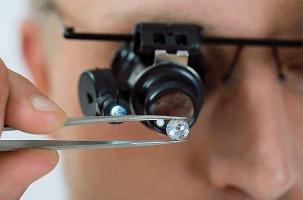The 4 C's of Diamond Grading

The 4 C's of Diamonds Explained
Unlike gold, silver and other precious metals, evaluating diamonds is as much an art as it is a science. Many things can affect the valuation of a diamond, mostly due to the famous four C's ; Carat, Color, Cut & Clarity. Your Diamond is unique, and we want to make sure you're properly educated on it's value. That's what makes us the most comfortable, trusted diamond buyers in Las Vegas.
Carat
One of the most important aspects of determining diamond value is it's size, or carat weight. Each carat is made of of 100 'points' so a 50 point stone would be half a carat. Larger diamonds are more desirable, and all other things being equal, will always be worth more money when selling than a smaller diamond. Usually diamonds that weigh one carat or more are considered to be 'larger', and will have considerably more value than a otherwise similar 99 point stone.
Color
The next important aspect of diamond grading is the diamond's color. Diamond colors are measured on a scale of D through Z. D is considered a perfectly white stone, while Z would be very very yellow or brown. Most gem quality stones fall between F and L colors. The more white the diamond is, the more money it will typically be worth. There are also colored diamonds. These fall into three groups; undesirable colors, such as brown (champagne or chocolate diamonds) and black; irradiated colors, which are artificially colored using different types of radiation; and finally, natural fancy color stones. With accompanying paperwork, natural fancy colored stones, such as fancy yellow, red, pink, green, and blue stones can be quite valuable. These naturally fancy colored diamonds are extremely rare.
Cut
The cut of a diamond encompasses a few different meanings. First off is the shape, which is most commonly round brilliant, but can also be princess cut, oval, pear, marquis, heart or dozens of other shapes. Of these, round brilliant stones tend to be the most popular and therefore the most valuable. The second meaning of 'cut' is the proportions of the diamond. Each stone will be cut slightly different depending on the shape of the raw diamond, meaning sometimes a round stone is deeper or more shallow than is considered ideal. There are 5 grades for the cut proportions; poor, fair, good, very good & excellent. Better cut grades make for a more valuable stones.
Clarity
Last, but certainly not least, is the diamond clarity. Natural diamonds can develop crystals, carbon spots, and other imperfections during their formation that cause inclusions. Depending on the clarity grade of the diamond, these inclusions can be barely visible under 10x magnification or they can be easily visible with the naked eye. The more visible inclusions, the worse the clarity grade will be. The clarity grades are as follows, from best to worst; F (Flawless), IF (internally flawless), VVS (very very slight inclusions) 1 & 2, VS (very slight inclusion) 1 & 2, SI (slight inclusions) 1,2 & 3, & finally I (inclusions) 1, 2 & 3.
With these four C's as the base of our diamond appraisal process, Rancho Gold & Jewelry is able to accurately evaluate diamonds. As some of the most experienced diamond buyers in Las Vegas, we buy diamonds of nearly every size & shape.
Visit us or call us at 702-626-0000 today and we would happy to answer any questions.
- by: Admin
- 21 Aug, 2018
- 7459 views